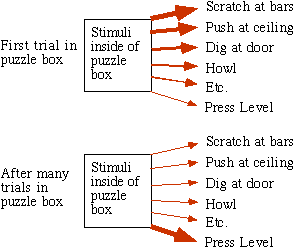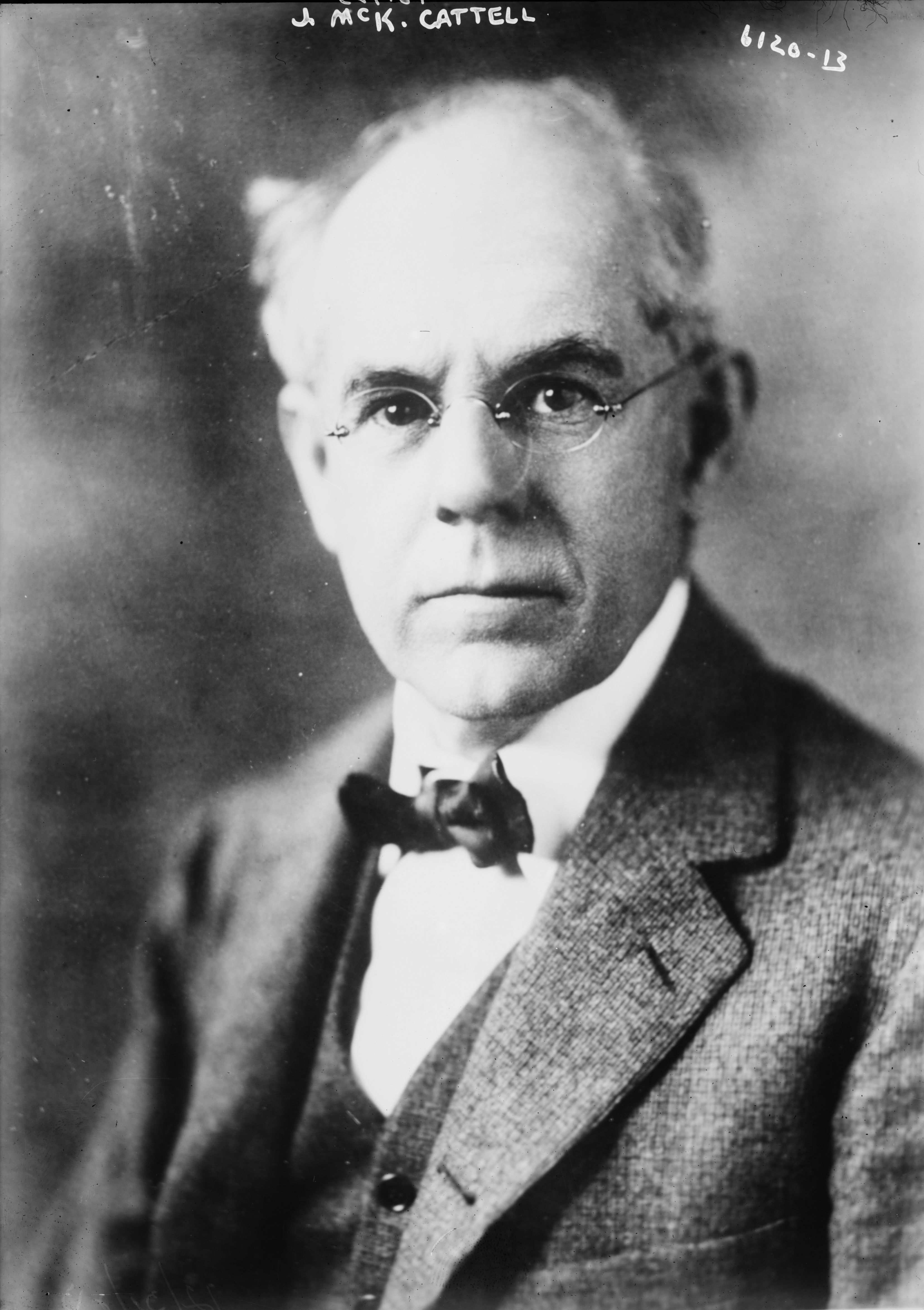|
Law Of Effect
The law of effect, or Thorndike's law, is a psychology principle advanced by Edward Thorndike in 1898 on the matter of behavioral conditioning (not then formulated as such) which states that "responses that produce a satisfying effect in a particular situation become more likely to occur again in that situation, and responses that produce a discomforting effect become less likely to occur again in that situation." This notion is very similar to that of the evolutionary theory, if a certain character trait provides an advantage for reproduction then that trait will persist. The terms "satisfying" and "dissatisfying" appearing in the definition of the law of effect were eventually replaced by the terms "reinforcing" and "punishing," when operant conditioning became known. "Satisfying" and "dissatisfying" conditions are determined behaviorally, and they cannot be accurately predicted, because each animal has a different idea of these two terms than another animal. The new terms, "re ... [...More Info...] [...Related Items...] OR: [Wikipedia] [Google] [Baidu] |
Psychology
Psychology is the scientific study of mind and behavior. Its subject matter includes the behavior of humans and nonhumans, both consciousness, conscious and Unconscious mind, unconscious phenomena, and mental processes such as thoughts, feelings, and motivation, motives. Psychology is an academic discipline of immense scope, crossing the boundaries between the Natural science, natural and social sciences. Biological psychologists seek an understanding of the Emergence, emergent properties of brains, linking the discipline to neuroscience. As social scientists, psychologists aim to understand the behavior of individuals and groups.Hockenbury & Hockenbury. Psychology. Worth Publishers, 2010. A professional practitioner or researcher involved in the discipline is called a psychologist. Some psychologists can also be classified as Behavioural sciences, behavioral or Cognitive science, cognitive scientists. Some psychologists attempt to understand the role of mental functions in i ... [...More Info...] [...Related Items...] OR: [Wikipedia] [Google] [Baidu] |
Edward Thorndike
Edward Lee Thorndike ( – ) was an American psychologist who spent nearly his entire career at Teachers College, Columbia University. His work on comparative psychology and the learning process led to his " theory of connectionism" and helped lay the scientific foundation for educational psychology. He also worked on solving industrial problems, such as employee exams and testing. Thorndike was a member of the board of the Psychological Corporation and served as president of the American Psychological Association in 1912. A '' Review of General Psychology'' survey, published in 2002, ranked Thorndike as the ninth-most cited psychologist of the 20th century. Edward Thorndike had a powerful impact on reinforcement theory and behavior analysis, providing the basic framework for empirical laws in behavior psychology with his law of effect. Through his contributions to the behavioral psychology field came his major impacts on education, where the law of effect has great influence ... [...More Info...] [...Related Items...] OR: [Wikipedia] [Google] [Baidu] |
Behaviorism
Behaviorism is a systematic approach to understand the behavior of humans and other animals. It assumes that behavior is either a reflex elicited by the pairing of certain antecedent stimuli in the environment, or a consequence of that individual's history, including especially reinforcement and punishment contingencies, together with the individual's current motivational state and controlling stimuli. Although behaviorists generally accept the important role of heredity in determining behavior, deriving from Skinner's two levels of selection: phylogeny and ontogeny. they focus primarily on environmental events. The cognitive revolution of the late 20th century largely replaced behaviorism as an explanatory theory with cognitive psychology, which unlike behaviorism views internal mental states as explanations for observable behavior. Behaviorism emerged in the early 1900s as a reaction to depth psychology and other traditional forms of psychology, which often had diffic ... [...More Info...] [...Related Items...] OR: [Wikipedia] [Google] [Baidu] |
George Romanes
George John Romanes (20 May 1848 – 23 May 1894) was a Canadian-Scots evolutionary biologist and physiologist who laid the foundation of what he called comparative psychology, postulating a similarity of cognitive processes and mechanisms between humans and other animals. He was the youngest of Charles Darwin's academic friends, and his views on evolution are historically important. He popularized the term neo-Darwinism, which in the late 19th century was considered as a theory of evolution that focuses on natural selection as the main evolutionary force. Romanes' early death was a loss to the cause of evolutionary biology in Britain. Within six years Mendel's work was rediscovered, and a whole new agenda opened up for debate. Early life George Romanes was born in Kingston, Canada West (now Ontario), in 1848, the youngest of three children, all boys, in a well-to-do and intellectually cultivated family. His father was Rev George Romanes (1805–1871), a Scottish Pres ... [...More Info...] [...Related Items...] OR: [Wikipedia] [Google] [Baidu] |
Connectionism
Connectionism is an approach to the study of human mental processes and cognition that utilizes mathematical models known as connectionist networks or artificial neural networks. Connectionism has had many "waves" since its beginnings. The first wave appeared 1943 with Warren Sturgis McCulloch and Walter Pitts both focusing on comprehending neural circuitry through a formal and mathematical approach, and Frank Rosenblatt who published the 1958 paper "The Perceptron: A Probabilistic Model For Information Storage and Organization in the Brain" in ''Psychological Review'', while working at the Cornell Aeronautical Laboratory. The first wave ended with the 1969 book about the limitations of the original perceptron idea, written by Marvin Minsky and Seymour Papert, which contributed to discouraging major funding agencies in the US from investing in connectionist research. With a few noteworthy deviations, most connectionist research entered a period of inactivity until the mid-1980 ... [...More Info...] [...Related Items...] OR: [Wikipedia] [Google] [Baidu] |
Reinforcement
In Behaviorism, behavioral psychology, reinforcement refers to consequences that increase the likelihood of an organism's future behavior, typically in the presence of a particular ''Antecedent (behavioral psychology), antecedent stimulus''. For example, a rat can be trained to push a lever to receive food whenever a light is turned on; in this example, the light is the antecedent stimulus, the lever pushing is the ''operant behavior'', and the food is the ''reinforcer''. Likewise, a student that receives attention and praise when answering a teacher's question will be more likely to answer future questions in class; the teacher's question is the antecedent, the student's response is the behavior, and the praise and attention are the reinforcements. Punishment (psychology), Punishment is the inverse to reinforcement, referring to any behavior that decreases the likelihood that a response will occur. In operant conditioning terms, punishment does not need to involve any type of p ... [...More Info...] [...Related Items...] OR: [Wikipedia] [Google] [Baidu] |
Operant Conditioning
Operant conditioning, also called instrumental conditioning, is a learning process in which voluntary behaviors are modified by association with the addition (or removal) of reward or aversive stimuli. The frequency or duration of the behavior may increase through reinforcement or decrease through punishment or Extinction (psychology), extinction. Origins Operant conditioning originated with Edward Thorndike, whose law of effect theorised that behaviors arise as a result of consequences as satisfying or discomforting. In the 20th century, operant conditioning was studied by Behaviorism, behavioral psychologists, who believed that much of mind and behaviour is explained through environmental conditioning. Reinforcements are environmental stimuli that increase behaviors, whereas punishments are stimuli that decrease behaviors. Both kinds of stimuli can be further categorised into positive and negative stimuli, which respectively involve the addition or removal of environmental stim ... [...More Info...] [...Related Items...] OR: [Wikipedia] [Google] [Baidu] |
Stimulus (psychology)
In psychology, a stimulus is any object or event that elicits a sensory or behavioral response in an organism. In this context, a distinction is made between the ''distal stimulus'' (the external, perceived object) and the ''proximal stimulus'' (the stimulation of sensory organs). *In perceptual psychology, a stimulus is an energy change (e.g., light or sound) which is registered by the senses (e.g., vision, hearing, taste, etc.) and constitutes the basis for perception. *In behavioral psychology (i.e., classical conditioning, classical and operant conditioning, operant conditioning), a stimulus constitutes the basis for behavior. The stimulus–response model emphasizes the relation between stimulus and behavior rather than an animal's internal processes (i.e., in the nervous system). *In experimental psychology, a stimulus is the event or object to which a response is measured. Thus, not everything that is presented to participants qualifies as stimulus. For example, a cross mar ... [...More Info...] [...Related Items...] OR: [Wikipedia] [Google] [Baidu] |
Puzzle Box
A puzzle box (also called a secret box or trick box) is a box that can be opened only by solving a puzzle. Some require only a simple move and others a series of discoveries. Modern puzzle boxes developed from furniture and jewelry boxes with secret compartments and hidden openings, known since the Renaissance. Puzzle boxes produced for entertainment first appeared in Victorian England in the 19th century and as tourist souvenirs in the Interlaken region in Switzerland and in the Hakone region of Japan at the end of the 19th and the beginning of the 20th century. Boxes with secret openings appeared as souvenirs at other tourist destinations during the early 20th century, including the Amalfi Coast, Madeira, and Sri Lanka, though these were mostly 'one-trick' traditions. Chinese cricket boxes represent another example of intricate boxes with secret openings. Interest in puzzle boxes subsided during and after the two World Wars. The art was revived in the 1980s by three pioneers ... [...More Info...] [...Related Items...] OR: [Wikipedia] [Google] [Baidu] |
Richard Herrnstein
Richard Julius Herrnstein (May 20, 1930 – September 13, 1994) was an American psychologist at Harvard University. He was an active researcher in animal learning in the Skinnerian tradition. Herrnstein was the Edgar Pierce Professor of Psychology until his death, and previously chaired the Harvard Department of Psychology for five years. With political scientist Charles Murray, he co-wrote ''The Bell Curve'', a controversial 1994 book on human intelligence. He was one of the founders of the Society for Quantitative Analysis of Behavior. Early life and education Richard Herrnstein was born on May 20, 1930, in New York City, to a family of Hungarian Jewish immigrants; the son of Flora Irene (née Friedman) and Rezso Herrnstein, a housepainter. He was educated at the High School of Music & Art and the City College of New York, receiving a B.A. from the latter in 1952. In 1955, Herrnstein obtained his Ph.D. at Harvard University, with a thesis titled ''Behavioral Consequences ... [...More Info...] [...Related Items...] OR: [Wikipedia] [Google] [Baidu] |
Matching Law
In operant conditioning, the matching law is a quantitative relationship that holds between the relative rates of response and the relative rates of reinforcement in concurrent schedules of reinforcement. For example, if two response alternatives A and B are offered to an organism, the ratio of response rates to A and B equals the ratio of reinforcements yielded by each response.Poling, A., Edwards, T. L., Weeden, M., & Foster, T. (2011). The matching law. ''Psychological Record'', 61(2), 313-322. This law applies fairly well when non-human subjects are exposed to concurrent reinforcement, variable interval schedules (but see below); its applicability in other situations is less clear, depending on the assumptions made and the details of the experimental situation. The generality of applicability of the matching law is subject of current debate. The matching law can be applied to situations involving a single response maintained by a single schedule of reinforcement if one assumes t ... [...More Info...] [...Related Items...] OR: [Wikipedia] [Google] [Baidu] |



